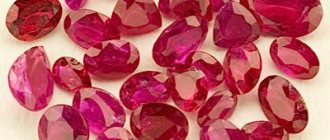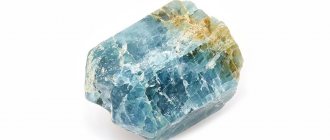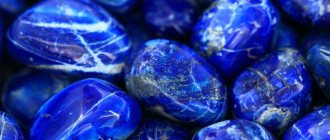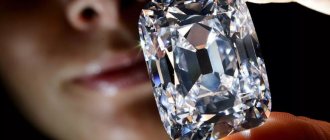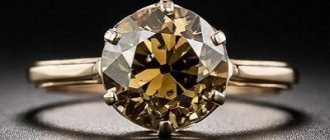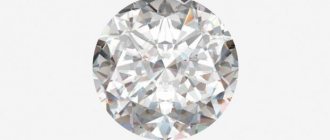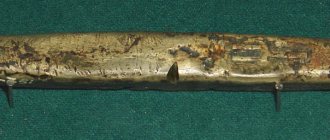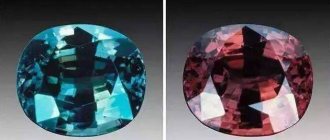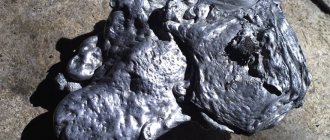| Category | Native element |
| Title in English | Diamond |
| Formula | C |
| Group | Carbon polymorphs |
| Color | Colorless, Yellow, Blue, Green, Brown, Red, Pink, Black, Blue, Gray, White |
| Stroke color | Absent |
| Shine | Diamond |
| Transparency | Transparent |
| singonia | Cubic |
| Hardness | 10 |
| Cleavage | Perfect |
| Density, g/cm³ | 3.47 - 3.55 g/cm³ |
| Kink | Conchoidal to splintery |
| origin of name | The name comes from the Greek word ἀδάμας, which translated into Russian means indestructible. This name was not chosen in vain, since diamond is the hardest type of mineral in the world. |
| Morphology | Due to the fact that diamonds dissolve in the kimberlite melt, dodecahedroid-shaped crystals appear. The formation of cuboids occurs as a result of atypical fibrous growth of diamonds. |
Diamond deposits
Diamonds are both rare and common gems.
Their deposits are found on all continents, with the exception of Antarctica. The main industrial deposits are located in Africa, Russia, Australia and Canada.
— Advertising —
The first known mines were Indian, but they were depleted at the end of the 19th century. In the 18th century, rich deposits of diamonds were discovered in Brazil. In the 19th century - in southern Africa.
In 2006, 176 million carats of diamonds were mined in the world, including $4.2 billion in Russia, $3.0 billion in Botswana, $1.7 billion in Canada, and $1.4 billion in South Africa. , in Angola for $1.2 billion.
The demand for these precious stones remains consistently high, but production is declining.
Extraction methods
Extraction of minerals to the surface is always associated with serious costs, and the choice of the method itself is largely determined by the depth of the ore rock. Often, having exhausted the capabilities of the surface layers, miners are forced to continue development, going deeper into the bowels of the earth.
Before starting the actual production of useful rock, it is necessary to conduct geological exploration, make a decision that is reasoned from various sides, create the necessary infrastructure, transport people and equipment, organize enrichment and processing.
Shakhtny
Where there is confidence in diamond deposits at a depth of more than 500 meters, the only mining method is the construction of underground structures. Although there are exceptions.
The method is quite expensive and unsafe, but very often it is the only one and also opens up access to new deposits. A serious problem in such cases is water and escaping gases; it is also necessary to constantly monitor the air supply and stable power supply. Inside the mine, mining equipment is constantly operating: combines, loading and unloading machines, conveyor belts, skips. After which the ore mined to the surface is sent for processing.
Career
An industrial method of diamond mining, used everywhere, but associated with drilling operations and the organization of explosions. The raw materials obtained in this way are loaded onto multi-ton dump trucks and sent to a processing plant that extracts diamonds from the rock.
Once one layer is exhausted, the quarry is expanded and deepened as long as conditions allow. If necessary, the mining process often moves into the closed stage of underground mine construction.
Diamond mining
Diamond history
From ancient Greek “adamas” is translated as “unsurpassed”.
— Advertising —
Scientists have not established the exact origin of this stone. There are various hypotheses for its origin. For example, one of them says that under high pressure at high depths, a cubic diamond crystal lattice is formed from carbon atoms. The stones are then carried to the surface by volcanic magma. There are known specimens of meteorite origin.
The age of diamonds is estimated to be from 100 million to 2.5 billion years.
Man-made and natural
Of course, there are not enough stones of these rare colors for everyone. That is why people have learned to create diamonds on their own, giving them a perfectly even color and shape.
According to the type of creation, diamonds are divided into:
- Natural. They come to the surface during the eruption of giant volcanoes and sometimes lie at great depths. From a liquid state, upon cooling, they become superhard crystals. It is in this form that geologists find them in kimberlite pipes or placers.
- Artificial (synthesized). Such stones almost completely replicate the structure of real diamonds. Moreover, the process of their production completely replicates the natural one. In special chambers, carbon is first exposed to enormous temperatures and high pressure, and then cooled and processed. These minerals are slightly cheaper than natural ones and are in great demand in the jewelry industry. They do not have foreign inclusions, so ideal color purity is always the prerogative of the “artificial” ones. Natural gems almost always have various impurities.
Physico-chemical characteristics of diamond
Diamond is an allotropic modification of carbon.
It is usually colorless or with a slight yellow tint. Diamonds colored red, orange, green or blue are very rare. The crystals are octahedral or dodecahedral, conchoidal at the fracture. With perfect cleavage, without pleochroism, transparent or opaque. Hardness on the Mohs scale is 10. Density is 3.52 g/cm3. Refractive index: 2.417.
Diamond is distinguished by its highest hardness, brittleness and high thermal conductivity.
The melting point of diamond is from 3700 to 4000 °C. In a stream of air, the stone burns at 850-1000 °C, in pure oxygen it burns at 720-800 °C. When heated to 2000 °C without air, it turns into graphite.
When exposed to sunlight or irradiation, the gem is capable of luminescing.
It is thanks to its high refractive index and high transparency that diamond is one of the most expensive gemstones. But in its natural form it is not considered beautiful. Only the cut transforms it into a stunning diamond with multiple internal reflections.
International classification of diamonds 4C
A rough diamond is a pale translucent or colored crystal of extraordinary hardness. Translated from Arabic, “almas” means “the hardest.” The Greeks gave it the name “adamas” - “indestructible”. After processing, the mineral takes on the appearance of a sparkling jewel.
Generally accepted classification of natural diamonds:
- Jewelry is the best representatives of these stones. They account for 20% of all precious minerals mined. Such gems can be cut and processed in other ways and weigh no less than 0.29 ct. They have no serious defects. The group of jewelry stones includes colorless (classic), colored (fancy) and black samples. The most common colored diamonds are yellowish, brown, gray, and brownish. A rare variety of diamonds - pink-purple, green, blue, red.
- Technical (80% of samples) are unsuitable for jewelry processing. This includes stones with a damaged structure, multiple inclusions, dull, almost opaque samples.
- Board (board) - diamond chips, fused crystals, fragments of minerals. Diamond beads are used in jewelry and industry for the manufacture of abrasive surfaces.
To assess the quality of cut diamonds, a special international classification of diamonds 4C has been adopted, which includes four parameters:
- Clarity - purity. The fewer inclusions a mineral contains, the better. To detect the smallest foreign inclusions, equipment that provides multiple magnification is used.
- Color – color. A separate criterion is the degree of its saturation and the nature of the shade for fantasy samples. The most valuable are colorless specimens, and among colored ones - stones of a pure shade without shimmer. The rarest are red diamonds.
- Carat – weight of the stone in carats (1 ct = 0.2 g). Crystals less than 0.29 cm are small, from 0.3 to 2.99 are medium, starting from 1 cm are large. If the weight of a stone is more than 5 ct, it is considered “especially large”. Giant diamonds heavier than 10 ct (the rarest diamonds) are given names. One large gem is more expensive than a handful of small crystals, even if their total weight is the same.
- Cut - cut. Processing helps to reveal the play of the stone, highlight the color and veil tiny defects.
Determining the quality of such precious stones is carried out using other methods:
- GIA – diamond grading developed by experts from the Gemological Institute of America;
- HRD (IDC) – classification proposed by the Higher Diamond Council of Belgium;
- CIBJO is a grading scale compiled by the International Confederation of Jewellery, Silver and Pearls;
- Scan D.N. – Scandinavian methodology;
- GOST is the Russian assessment system.
Types of diamond
The cut of a diamond depends on the shape of the diamond, since they try to reduce its loss in this process to the possible minimum, on average it is 55-70%.
Depending on the processing technology, rough diamonds are distinguished:
- “soubles”, regular octahedral crystals that are sawn in two and then used to create two diamonds;
- "makebles", irregular or rounded crystals that are cut "in one piece";
- “cleavage” contain cracks, they are split before processing.
For diamonds, depending on the cut, the following varieties are distinguished:
- round (contains 57 edges);
- fantasy: oval, “pear”, “marquise”, “princess”, “radiant”.
Diamond cutting centers of global importance are located in India, Israel, China, Russia, Ukraine, Thailand, Belgium, and the USA.
The magical properties of diamond
Diamond is a symbol of innocence, perseverance and courage, perfection, the will to win and power.
It strengthens its owner, makes him courageous and strong, gives him happiness and good luck, protects him from the evil eye and damage. In general, the gem helps to reveal the best qualities of its owner. It is believed that diamonds should not be purchased on your own; it is important to receive the gem as a gift. But we must take into account that such a gift is a guarantee of love and fidelity. Both the giver and the recipient of the stone bind themselves with strong bonds.
In the East, it is customary to give and inherit diamonds. Purchased stones are worn only after 7 years. And stolen or ill-gotten diamonds bring misfortune and death.
In addition, diamonds with defects can also cause trouble.
In our time
Diamonds, which is what cut diamonds are called, are in great demand in the world of socialites. Necklaces, rings, brooches, tiaras, pendants – you won’t see diamonds in any kind of jewelry. The abundance of jewelry in our time is pleasing; one’s eyes simply run wide from such luxury. Every self-respecting representative of high society is simply obliged to have at least one piece of diamond jewelry in their collection. This is practically a ticket to a social event, emphasizing the majesty and status of the person who wears the jewelry.
This precious mineral has become so popular that the term “diamond color” has been coined. This characterizes the material as clean, transparent and playing with all colors.
In fact, this miracle stone has become so popular that it can be found not only in the jewelry world or the technical industry. Quite a lot of diamond emblems can be seen, which emphasizes the richness of the product that is provided by the company that produces it. Tattoos with the image of a diamond have become popular among young people, signifying the strength of character of the person who decided to immortalize this stone on his body.
It has long been believed that the owner of a piece of jewelry has a naturally strong, majestic character and incredible fortitude.
Healing properties of diamond
Diamonds reduce fever, help the body fight infections, relieve fatigue, stimulate metabolism, and help in the treatment of gastrointestinal diseases and insomnia.
Diamond amulets are used for skin diseases, schizophrenia and depression.
Ayurveda notes the rejuvenating properties of the gem.
It is believed that a diamond ring strengthens the owner’s body and protects his health.
Diamond Applications
Cut diamonds, called diamonds, are one of the most expensive and popular gemstones.
Therefore, most natural diamonds are used in their production. As an exceptionally hard material, diamond is used in industry: in the manufacture of knives, drills, and cutters. Diamond powder is an excellent abrasive in the production of cutting and sharpening wheels.
In addition, diamonds have found application in quantum computers, the watch and nuclear industries, and microelectronics.
Diamond colors
Diamonds are predominantly colorless, sometimes exhibiting a faint to strong tint of pale yellow, yellow or brown.
Absolutely transparent specimens are called stones of “pure water” and are valued above all others.
In nature, there are also unique specimens of pink, blue, green and red.
Compatibility with zodiac signs
The mineral is indifferent to Scorpios, and can also harm Geminis, making them even less self-confident. Diamond suits Aries well - they can use stones of any color to strengthen their feelings and character. The stone is also useful for other zodiac signs:
- Calf. It is best to choose pale green or pale yellow stones. They will become a talisman and will weaken the negative impact of people around you.
- Cancer. The gem is able to calm Cancer, bring him out of depression and help him develop his skills. Blue, transparent minerals are suitable.
- A lion. Helps you become more patient, forgiving and understanding. Bright yellow and black diamonds are especially effective.
- Virgo. It will give you confidence and help improve your financial situation and family relationships. The most suitable option are red and ginger stones.
- Sagittarius. Diamond brings good luck to this zodiac sign. The best choice is brown and black diamonds.
- Capricorn. The gem helps to achieve success both in career and in love affairs. Bright green, blue and purple minerals have an effective effect.
Helpful information
Aquarius and Libra can only wear yellow stones, and Pisces can only wear blue ones. Otherwise, a diamond can attract bad luck, strengthen negative character traits, and make its owner psychologically unstable.
Artificial diamond
The first synthetic diamonds were produced in the middle of the last century.
Nowadays, man-made diamonds are known as HPHT diamonds and CVD diamonds, according to the methods used to produce them. The abbreviation HPHT means "high pressure and temperature" in English, and CVD translates as "chemical vapor deposition". In fact, artificially created diamonds are also pure carbon, that is, they are no different from natural ones, except for their origin.
There are also methods for their production, such as detonation synthesis and high-power ultrasound treatment of graphite.
Synthetic diamonds are mainly used in industry.
How to distinguish a real diamond from a fake
Colorless zircons, sapphires, and crystal are used as fake diamonds. To distinguish a fake stone:
- They look at it in the sun. A real diamond shows one bright point, while imitation diamonds allow light to pass through.
- Thermal conductivity is measured, which is very high in diamond, unlike other stones.
- They use a felt-tip pen with thick ink, which leaves a straight line on the surface of a natural diamond, and separate drops on a fake diamond.
- An aluminum stick is used. It will not leave a mark on a wet natural stone, but on a fake one it will form a clear silver line.
But distinguishing a natural diamond from a synthetic one is almost impossible.
In any case, it is better to entrust the diamond assessment to a specialist, since it is quite difficult to distinguish a high-quality fake.
Prices for diamond products
The price of diamonds depends on the weight, quality of cut, color and clarity of the stone.
1 carat is 200 mg. Stones weighing from 15 carats are rare, and more than 100 carats are unique. The most popular diamonds weigh 0.1 carats and cost up to $200. Samples weighing from 1 carat cost from $5,000 per carat.
Interesting facts about diamond:
- About 26 tons of diamonds are mined annually in the world.
- There are no two absolutely identical diamonds, just like identical fingerprints.
- The custom of proposing marriage along with a diamond ring dates back to the 15th century, when the Archduke of Austria first used such a “move” to get a positive response from the bride.
- Diamonds are the heroes of many works of art. For example, they are found in “The Three Musketeers” by Dumas and in “The Twelve Chairs” by Ilf and Petrov. And thanks to the film “Gentlemen Prefer Blondes,” the phrase that “diamonds are a girl’s best friend” became a catchphrase.
- The Heart of the Ocean stone from the Titanic has a real prototype - a blue heart-shaped diamond weighing about 14 carats. It was sold at Christie's in 1995 for $7,791,000.
European classification by purity groups
One of the price-determining indicators for natural diamonds is the presence of cracks, chips, hard and gas inclusions, and impurities that impart pigmentation. External and internal defects affect the quality of the crystal because they prevent the stone from fully reflecting color.
It is customary in the world to classify diamonds according to purity groups, designated by Latin letters:
- FL (Flawless) – crystal clear without inclusions.
- IF (Internally Flawless) - samples without inclusions, but with external defects - cracks, scratches.
- VVS (Very Very Small Inclusions) are minerals with tiny inclusions that cannot be seen without the use of powerful magnifying devices.
- VS1, VS2 (Very Small Inclusions) - crystals in which there are inclusions of such a size that they can be seen with a 10* jewelry loupe.
- SI (Small Inclusions) - gems containing foreign impurities that are clearly visible through a 10x magnification magnifying glass.
- I (imperfect) – diamonds containing inclusions visible to the naked eye.
This is a European classification that allows even a non-specialist in jewelry to get an accurate idea of the quality of a diamond.
